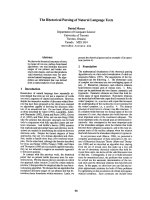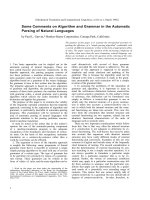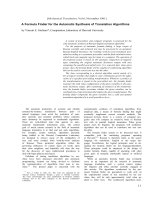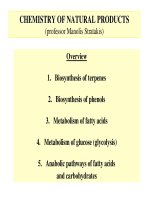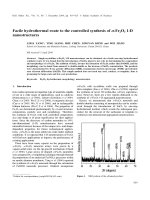Volume 3 the total synthesis of natural products
Bạn đang xem bản rút gọn của tài liệu. Xem và tải ngay bản đầy đủ của tài liệu tại đây (28.22 MB, 689 trang )
THE TOTAL SYNTHESIS
OF NATURAL PRODUCTS
The Total Synthesis
of Natural Products
VOLUME 3
Edited by
John ApSimon
Department of Chemistry
Chrleton University, Ottawa
A WILEY-INTERSCIENCEPUBLICATION
John Wdey & Sons,
New York
London
Sydney
Toronto
A NOTE TO THE READER
This book has been electronically reproduced from
:digitalinformation stored at John Wiley & Sons, Inc.
We are pleased that the use of this new technology
will enable us to keep works of enduring scholarly
value in print as long as there is reasonable demand
I for them. The content of this book is identical to
previous printings.
~
Copyright 0 1977, by John Wley Jc Sons, Inc.
All rights reserved. Published simultaneously in Canada.
N o part of this book may be reproduced by any means, nor
transmitted, nor translated into a machine language without
the written permission of the publisher.
Library of Congress Cataloging in Publication Data:
ApSimon, John.
The total synthesis of natural products.
Includes bibliographical references.
1. Chemistry, Organic-Synthesis. 1. Title.
QD262.A68
54T.2
ISBN 0-471-02392-2 (V.3)
10 9 8
72-4075
Contributors
to Volume 3
T. Kametani, Tohoku University, Sendai, Japan
J. P. Kutney, University of British Columbia, Vancouver, Canada
R. V. Stevens, University of California, Los Angeles, California
Preface
Throughout the history of organic chemistry, we find that the study of natural
products frequently has provided the impetus for great advances. This is certainly true in total synthesis, where the desire to construct intricate and complex
molecules has led to the demonstration of the organic chemist’s utmost ingenuity in the design of routes using established reactions or in the production of
new methods in order to achieve a specific transformation.
These volumes draw together the reported total syntheses of various groups
of natural products and commentary on the strategy involved with particular
emphasis on any stereochemical control. No such compilation exists at present,
and we hope that these books will act as a definitive source book of the successful synthetic approaches reported to date. As such, it will find use not only with
the synthetic organic chemist but also perhaps with the organic chemist in
general and the biochemist in his specific area of interest.
One of the most promising areas for the future development of organic chemistry is synthesis. The lessons learned from the synthetic challenges presented by
various natural products can serve as a basis for this ever-developing area. It is
hoped that these books will act as an inspiration for future challenges and outline the development of thought and concept in the area of organic synthesis.
The project started modestly with an experiment in literature searching by a
group of graduate students about nine years ago. Each student prepared a
summary in equation form of the reported total syntheses of various groups of
natural products. It was my intention to collate this material and possibly
publish it. During a Sabbatical leave in Strasbourg in 1968-1969,I attempted to
prepare a manuscript, but it soon became apparent that the task would take
many years and I wanted to enjoy some of the other benefits of a sabbatical
leave. Several colleagues suggested that the value of such a collection would be
enhanced by commentary. The only way to encompass the amount of data
Vii
viii
Preface
collected and the inclusion of some words was to persuade experts in the various
areas to contribute.
Volume 1 presented six chapters describing the total synthesis of a wide
variety of natural products. The subject matter of Volume 2 was somewhat more
related, being a description of some terpenoid and steroid syntheses. The present
volume considers the syntheses of several classes of alkaloids. The authors originally provided me with their manucripts three years ago, and the delay in producing this volume is a result of a hope that another planned chapter would also
appear in time for inclusion. Unfortunately, the author of that chapter has been
unable to produce his contribution.
I have asked the authors of these chapters to provide wherever possible, an updating of their work by the use of supplementary references and addenda. The
delay in producing the original work is in no way the fault of the present
authors, and I apologize to them for this tardiness. However, I believe that their
work is outstanding and well worth publishing. I hope the readers of this volume
will find it useful as a reference work on total syntheses preformed in the
alkaloid field.
I wish to express my thanks to Ms.Karen Bergenstein for preparing the index
and to Karl Diedrich for preparing the illustrations t o Chapter 2.
JOHN APSIMON
Ottawa, Cbnado
January 1977
Contents
The Total Syntheses of Isoquinoline Alkaloids
1
T. KAMETANI
The Synthesis of Indole Alkaloids
273
J. P. KUTNEY
Alkaloid Synthesis
439
R. V. STEVENS
Compound Index
555
Reaction Index
564
The Total Synthesis of Natural Products, Volume3
Edited by John ApSimon
Copyright © 1997 by John Wiley & Sons, Inc.
The Total Syntheses of
Isoquinoline Alkaloids
TETSUJI KAMETANI
P!tarmaceuticuI Institute.
Tohoku Univerxity,
Aobayama, Sendai, Japun
1. General Methods
A. Introduction
B. Type 1 Synthesis
C. Type 2 Synthesis
D. Type 3 Synthesis
E. Type 4 Synthesis
F. Type 5 Synthesis
2. Stereochemical Problem in the Synthesis of Isoquinoline Alkaloids
A. Total Syntheses by Resolution of Racemate
B. Total Syntheses Using Optically Active Intermediates
C. Stereospecific Total Syntheses
3. Total Synthesis by Phenol Oxidation
A. Simple Isoquinoline Alkaloids
B. 2-Benzylisoquinoline Series
C. 1Benzylisoquinoline Series
D. Amaryllidaceae Alkaloids
E. Phenethylisoquinoline Alkaloids
4. Photochemical Synthesis
A. Photolytic Electrocyclic Reaction
B. Photochemical Transannular Reaction
3
3
5
59
66
66
68
79
80
84
96
121
121
121
122
156
160
170
170
184
*The author is deeply indebted to Dr. Keiichiro Fukumoto and Dr. Shiroshi Shibuya, Pharmaceutical Institute, Tohoku University, for many help for suggestions, as well as for help
in the preparation of this review.
1
2
'I
he Total Syntheses of Isoquinoline Alkaloids
186
C. Photo-Pschorr Reaction
D. Photolytic Cyclodehydrohalogenation
E. Photolytic Cleavage
F. Azepine Synthesis
5. Special Topics
A. Pschorr Reaction
B. Benzyne Reaction
C. Ullmann Reaction
D. Rearrangement
E. Azepine Alkaloids
References
188
199
200
201
20 1
215
223
226
24 3
25 1
Isoquinoline or benzo[c]pyridine, an isomer of quinoline, was first obtained
from coal tar by Hoogewerff and van Dorp in 1885 together with various alkylisoquinolines, and isoquinoline itself was synthesized by Gabriel in the same
year. However, the natural occurrence of the isoquinoline ring system was first
recognized in the opium alkaloid; papaverine, isolated as needles, m.p. 147',
CZOH2104N,by Goldschmidt,' in one of the first structural determinations of
alkaloids. Since Goldschmidt's recognition, efforts by chemists have been
devoted to the chemistry of the alkaloids and by now about 1000isoquinoline
alkaloids are known?
The numbering of isoquinoline ring system is shown as follow.
5
4
8
1
Isoquinoline is obtained as hygroscopic colorless crystals, m.p. 24.6", b.p.,,
243.3', b . ~ 142'
. ~ with
~ pKa 5.14 in water at 20'. The odor of isoquinoline is
almost the same as that of quinoline, but the former smells somewhat likes
benzaldehyde. The basicity of isoquinoline is stronger than that of quinoline,
which has pKa 4.85 in water at 20'. Electronically, the chief difference between
naphthalene and isoquinoline is due to the fact that the latter, isoquinoline has
the "lone pair" at its nitrogen atom. Furthermore, the nitrogen attracts electron
density from the carbon atoms so that these carbon atoms have a deficiency of
the electron charge compared with the atoms in naphthalene? Quantitatively,
the charge on each atom can be calculated by the valence bond method or by
the method of molecular ~ r b i t a l s . ~
1. GeneralMethods
3
n-Electron Densities for Isoquinoline
1.0
1.0
0.996 0.938
0 . 9 3 8 m 0.912
0.940 m
N
O
:
9
:
:
1.0 \
/N 1.419
0.984 \
0.933 0.866
0.948 0.767
M,0.Method
V. B. Method
In general, it would be expected that substitution with electrophilic reagents
would occur at the carbon having the greatest n-electron density and that substitution with nucleophilic reagents would occur at the position having the smallest n-electron density.
1. GENERAL METHODS
A. Introduction
The methods for the synthesis of isoquinoline ring system can be classified systematically in five ways according to the mode of formation of the pyridine ring
(Chart 1-1). The first type involves ring closure between the benzene ring and
Chart 1-1.
The 1
x;?&>
Type 2
TYW 3
\
Type 4
TVpe 5
the carbon atom, which forms the C,-position of the resulting isoquinoline ring.
The second type uses bond formation between the C1-position and nitrogen, and
the third type uses cyclization by the combination of nitrogen with the Cyposition. The fourth type is due to the formation of isoquinoline ring by ring closure
between the C3- and C4-position. The fifth type necessitates ring closure
between the benzene ring and C4-position.
4
The Total Syntheses of lsoquinoline Alkaloids
In the Chart 1-1, the dotted lines indicate the bond formation by cyclization.
Although all the types of these reactions are known, the most popular reactions
are the type of 1 and 5 , giving usually dihydro- or tetrahydroisoquinoline
derivatives and aromatic isoquinolines can be prepared by the dehydrogenation
of the corresponding dihydro- or tetrahydroisoquinolines. Among reactions of
type 1 and 5 , the Bischler-Napieralski, Pictet-Spender, and Pomeranz-Fritsch
reactions are especially important.
chart 1-2.
Me0 \
OMe
OMe
OMe
2
1
8'
Me0 \
OMe
6
Papaverhe
4 Laudanosine
@
Me0 \
OMe
5
I-
1. GeneralMethods
5
B. Type 1 Synthesis
BischlerNapiemlskiReaction4 (chart 1-2)
The Bischler-Napieralski route involves the cyclodehydration of an acyl derivative 1 of 0-phenethylamine in the presence of a Lewis acid such as phosphoryl
chloride or phosphorous pentoxide in an inert solvent to give a 3,4dihydroisoquinoline 2, which must be reduced to a 1,2,3,4-tetrahydroisoquinoIine 3
since the isoquinoline alkaloids' exist as the tetrahydro derivatives in most
cases. For this purpose, 3,4-dihydroisoquinoline hydrochloride can be directly
reduced with sodium borohydride to give the tetrahydroisoquinoline derivative
3.6 When the N-methyl derivative 4 is desired, the Eschweiler-Clarke reaction of
3 with formalin and formic acid or sodium borohydride gives the expected
N-methyl compound 4.' Reduction of the methiodide 5 of a 3,4dihydroisoquinoline with sodium borohydride to 4 is also recommended.' Recently,
cinnamolaurine was synthesized by this method as shown Chart 1-3A.'" On
the other hand, the mild dehydrogenation of a 3,4-dihydroisoquinoline 2 can be
Chart 1-3A.
Cinnamolaurine
6
The Total Syntheses of Isoquinoline Alkaloids
carried out to obtain the aromatic isoquinoline alkaloids such as papaverine 6.9
One of the most important modifications of the Bischler-Napieralski reaction
was introduced by Pictet and Gams." This reaction gives the isoquinoline derivative instead of the 3,4-dihydro-compound by cyclization of a P-hydroxy-0phenethylamide 7 with phosphorous pentoxide. For example, papaverine 6 was
obtained directly from 7 (Chart 1-3).
Chut 1-3.
OMe
7
Application of the Pictet-Cam's modification to 0-methoxyQ-phenethylamide 7a also gives the isoquinoline derivatives 6, directly." Therefore, the
choice of the foregoing variation of the Bischler-Napieralski reaction should be
made according to the availability of the starting amide (Chart 1-4).
Chart 14.
OMe
OMe
7r
Oximes 8, which could lead to N-acyl-0-phenethylamide 9 by Beckmann
rearrangement, are also useful as starting materials for the Bischler-Napieralski
route, a method applied t o the synthesis of carnegine lo'* (Chart 1-5).
These oxirnes are converted into the corresponding isoquinolines or 3,4dihydroisoquinolines without isolation of the amides formed as intermediate^.'^
1. GeneralMethods
7
Chatt 1-5.
10 Carnegme
The benzenesulfonyl ester 11 of an oxime undergoes cyclization to give the
3,4-dihydroisoquinoline derivative 12 by heating alone without any other
reagentI4 (Chart 1-6). In some cases, the amidine, instead of the amide, is used
Chart 1-6.
-
+
PhSOjH
Me
12
for cyclization to give the phenanthridine derivatives in good yield^.'^ Short and
BrodrichI6 synthesized 3,4-dihydro-l -phenylisoquinoline 13 from amidine 14 by
treatment with phosphoryl chloride (Chart 1-7).
8
mN‘“-aN
The Total Syntheses of Isoquinoline Alkaloids
Chart 1-7.
H~N’
14
c’
‘m
Ph
13
N-P-Phenylethylurea and urethane derivatives are also useful for the syntheses
of 3,4-dihydroisoquinolines having an amino or hydroxyl group at the Cl-position.” For example, an urethane 15 yields 3,4-dihydro-l -hydroxy-6,7,8-trimethoxyisoquinoline 16,18 which was converted into anhalamine 17 by BrossiI8
(Chart 1-8).
Chart 1-8.
M
Me0e \
o m N H
OMe C=O
I
OEt
P.P.A.
15
OH
17 Anhalamine
Similarly, the isocyante was converted into the isocarbostyril, which was transformed into haemanthidine and tazettine18“ (Chart 1-8A).
Syntheses of PArylethylamides
Since the syntheses of N-acylarylethylamines are very important, as starting
materials for Bischler-Napieralski reaction, and representative synthetic methods
to the amides are described as f o l l o ~ ~ . ~ ~ ~ ~ ~
Schotten-Baumann Reaction (Chart 1-9). This reaction involves an acylation of
amines by treatment with an acyl chloride under ice-cooling in dilute alkaline
solution. In the case of substances labile to strong alkali, weaker alkaline
reagents such as sodium carbonate, bicarbonate, or triethylamine can be used. In
some cases, an excess of amine is used to remove the resulting hydrogen chloride
Chart 1-8A.
...OMe
HO
Haemanthidme
9
10
The Total Syntheses of Isoquinoline Alkaloids
Chart 1-9.
OMe
OMe
18
19
as its hydrochloride. Acylation with acid chloride in anhydrous pyridine also
gives the amide in good yield. Sugasawa directly synthesized papavexhe 6 by
heating a mixture of the amine 18 and carboxylic acid 19, without the isolation
of the corresponding amide, in the presence of phosphoryl chloride.2' The modification of this method was carried out by Battersby as follows.21" The carboxylic acid was treated with ethyl chlorocarbonate in the presence of triethylamine in dimethylformamide at -So, and the resulting mixed anhydride, without
isolation, was condensed with the homoveratrylamine at -5-0' to afford the
amide (Chart 1-10).
chart 1-10.
Me0
ClC0,Et
Et,N
*
c
"-Et
The Condensation of a Carboxylic Acid with an Isocyanate (Chart 1-11).
h i d e s , which are difficult to prepare by the Schotten-Baumann or other reactions, can often be obtained by the condensation of isocyanates with car-
1. General Methods
11
boxylic acids. For instance, Sugasawa and Shigehara” prepared the amide 20 by
the condensation of 2 moles of 3,4-dimethoxyhydrocinnamicacid azide 21 with
y,y-ethoxycarbonylpimelic acid 22.
Chat 1-11.
+
Me0 \
COOEt
I
HOOC-CH2CH, -C-CH* CH2-COOH
I
m C O N 3
COOEt
21
-
22
EQ?NH
ocI
COOEt
I
Qz
HN
CH2CH2-C-CH2
I
COOEt
I
CHa
20
In this reaction, the a i d e 21 can be converted into the corresponding isocyanate as an intermediate by heating in benzene solution, and the resulting
isocyanate can also be used for the condensation, but normally a mixture of the
wide 21 and dicarboxylic acid is heated in benzene to give the amide 20 directly. When the materials are not dried completely the urea derivative is formed as
a by-product.
Chart 1-12.
23
H2C24
12
The Total Syntheses of Isoquinoline Alkaloids
The Condensation of an Amine with an Azide (Chart 1-12). This procedure uses
the acylation of the amine with azide in cold solvent. Since this reaction is quite
different from the preceding method, it must be carried out without formation
of isocyanate from the azide. For example, 4-nitrohippuro-P-veratrylethylamide
23 was prepared by the condensation between 4-nitrohippuric acid azide 24 and
homoveratrylamine.23
The CondensationBetween an Ester and an Amine (Chart I-12A). By heating or
fusion of a mixture of an ester and an amine, the amide can be obtained easily.
N-(3Benzyloxy4,ldime thoxyphene thyl)-5-benzyloxy-2-bromo4methoxyphenylacetamide 25 was prepared from 3-benzyloxy4,5-dimethoxyphenethylamine26
with methyl 5-benzyloxy-2-bromo-4-methoxyphenylace
tate 27.%
Chst 1-12A.
Me0e \
M
0 m N H 2
PhCHZO
26
+
___t
COOMe
PhCHzO
CO
25
OCHZPh
27
Application of the Amdt-Eistert Reaction (Chart 1-13). This procedure involves the conversion of an acid to the amide via the diazoketone prepared
from an acid chloride. In the presence of a suitable catalyst, such as colloidal
silver, platinum, or copper, the diazoketone produces a ketene that reacts with
an amine, leading to the formation of the corresponding amide. For example,
Kametani prepared the amide 31 for the synthesis of dauricine 28. The diazoketone 29 prepared from acid chloride 30 was reacted with homoveratrylamine
13
1. GeneralMethods
Chart 1-13.
30
c
H
,
N
F
AgOCOPh
29
28 Dauricine
to give the corresonding amide 31." This type of a double Bischler-Napieralski
reaction is used for a synthesis of O-methylda~ricine~~~
and cepharanthine?'*
Other Amide Syntheses. Beckmann rearrangement of an oxime can also give an
amide, and, in many instances, further cyclization to isoquinoline is known to
occur during the course of the foregoing reaction." Furthermore, a mixture of
arylethylamine and carboxylic acid gives the corresponding amide on heating to
170 to 180°.26 On the other hand, Ritter and Murphy27 obtained the 3,4-dihydro-3-methylisoquinolinefrom the nitrile and an allylbenzene in the presence
of concentrated sulfuric acid, but not the amide. When the amine and/or carboxylic acid are susceptible to acid, base, or heat, a mixture of the amine and carboxylic acid is treated with dicyclohexylcarbodiimide as a condensation
reagent in methylene dichloride at room temperature in order to obtain the
corresponding amide (Chart 1-13A).27b
14
The Total Syntheses of lsoquinoline Alkaloids
Chart 1-13A.
COZH
co
DCC
b
O M
Me0
e
%M
. eMe0
Direction of Ring Closure (Chart 1-14)
Cyclization of m-meth0xy-P-phenethylamide32 would be expected to give
either 6-methoxy- or 8-methoxy-3,4-dihydroisoquinolinedepending on the
direction of ring closure. When the para position to the methoxyl group has no
substituent, cyclization preferentially occurs at the para to give a 6-methoxyisoquinoline derivative 33. When the para position is blocked, cyclization will
proceed to the orrho position to the methoxyl group. For instance, Nacetyl-2,5dimethoxyphenethylamine 34 was readily converted to 3,4dihydro-5,8-dimethoxy-1-methylisoquinoline3S2"' (Chart 1-15).
Chatt 1-14.
Meo W
H
i
co
Meom
/
R
33
I
32
R
m
N
OMe R
If both available positions are activated to a similar extent, a mixture of both
cyclized products is obtained, as in the case of cyclization of N(3-benzyloxy4,5-dimethoxyphene thyl)-4-benzyloxy-3-methoxyphenylacetamide36 to the 8benzyloxy-6,7-dimethoxy-37 and 6-benzyloxy-7,8-dimethoxy-3,4-dihydroisoquinoline derivative 38.% Moreover, the cyclic bisamide 39 also gave stebisimine
-a
Chart 1-15.
OMe
OMe
m
\H
Me0
c?
34
Me
OMe Me
35
Ey phFy
Chart 1-16.
FOCI,
C6H6 .L
PhCH20
NE;g
PhCH20 \
OMe
UMe
PhCH20
OMe
38
37
36
f
mC-$ZomHco
Me0 \
\
POCIS
yp0a
\
CHCI,
40 Stebisimine
+
39
41
15
16
T h e Total Syntheses of lsoquinoline Alkaloids
Chart 1-16A.
Stebisimine
NaBH,
Me0
40 and its isomer 41 on c y ~ l i z a t i o n(Chart
~ ~ 1-16). Stebisimine was converted
into obaberine by reduction and methylationBa (Chart 1-16A).
In an attempt to synthesize a berberine, the formamide 42 was treated with
phosphoryl chloride to yield the bromine-free compound 43 rather than the
expected bromodihydroberberine 43a. This result is a remarkable instance of the
preferred direction of ring closure, a bromine atom being removed to allow cyclization to proceed at the para position to the electron-releasing group?' However,
Kametani has assumed that the replacement of methoxyl by hydroxyl offsets
the inactivation of the nucleus caused by the Ieffect of the bromine atom,
leading to the cyclization at the ortho position to the hydroxyl group. Thus
N-(2-bromo-5-hydroxy-4-methoxyphenethyl)-4-methoxyphenylacetamidegave
the 5-bromo-3,Pdihydto-8-hydroxy-7-methoxyisoquinoline
derivative by the
action of phosphoryl chloride in chloroform, which was converted into petaline
44 by the standard method. Recently, 8-oxygenated isoquinoline derivatives
were obtained in the cyclization of rmns-N-[2-(3-methoxyphenyl)cyclohexyl]benzamide, but the main product was 6-methoxyisoquinoline derivative"'
(Chart 1-17). Moreover, TaniNb achieved a cyclization of the formamide to the
expected bromodihydroprotoberberine and succeeded in a synthesis of cheilanthifoline. This route provides a useful method for the total synthesis of the
9,lO-&substituted protoberberine alkaloids (Chart 1-17A).
This method is applied to the synthesis of caseadine-type corn pound^.^^^ Moreover, this problem was circumvented by using an ethoxycarbonylamino-0-phenethylaniide in order to activate the para position and thus to effect the required
Chart 1-17.
Me0 \
0%
6HO
/
0 1
OH
43
42
OMe OH
17
18
The Total Syntheses of Isoquinoline Alkaloids
Chart 1-17A.
Cheilanthifoline
cyclization reaction. Conventional steps then led to the phenolic isoquinoline,
which gave (&)-~ularine~'~
under Ullmann reaction (Chart 1-17B).
Chart 1-17B.
EtOzCHN
PhCH2O
Me0 \
OMe
KOH
H2N 7/m
PhCH2O
Me1
PhCHzO
OMe
z H O s +
.H
:3
HCI
NaBH,*
7
HO
/
Me0 \
OMe
Me0 \
OMe




